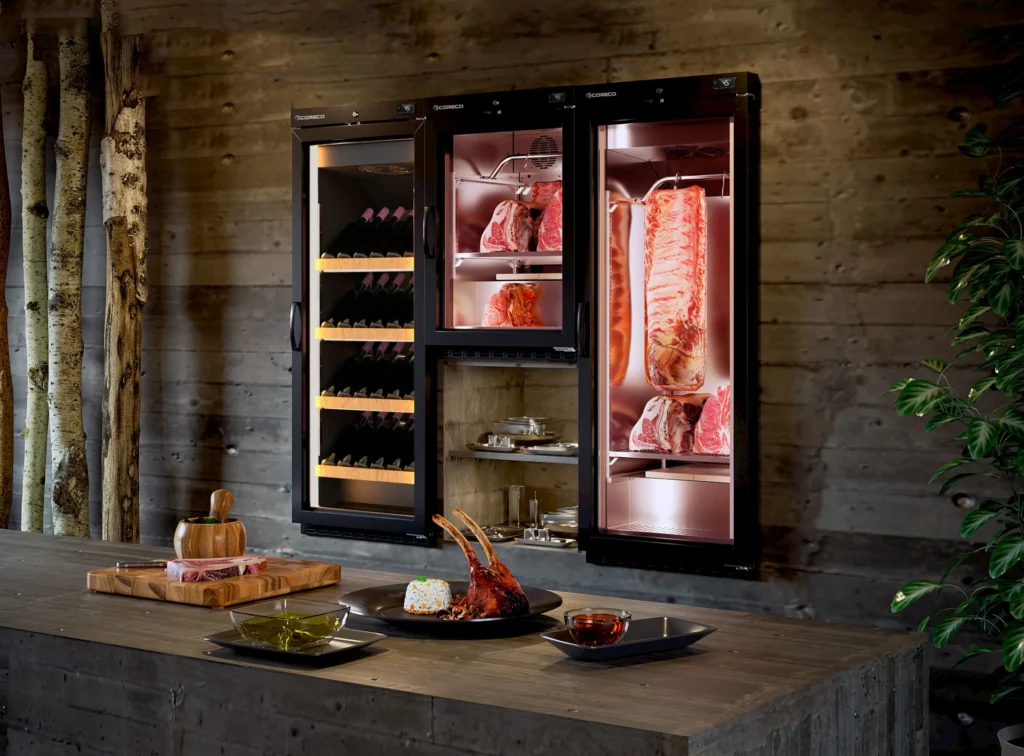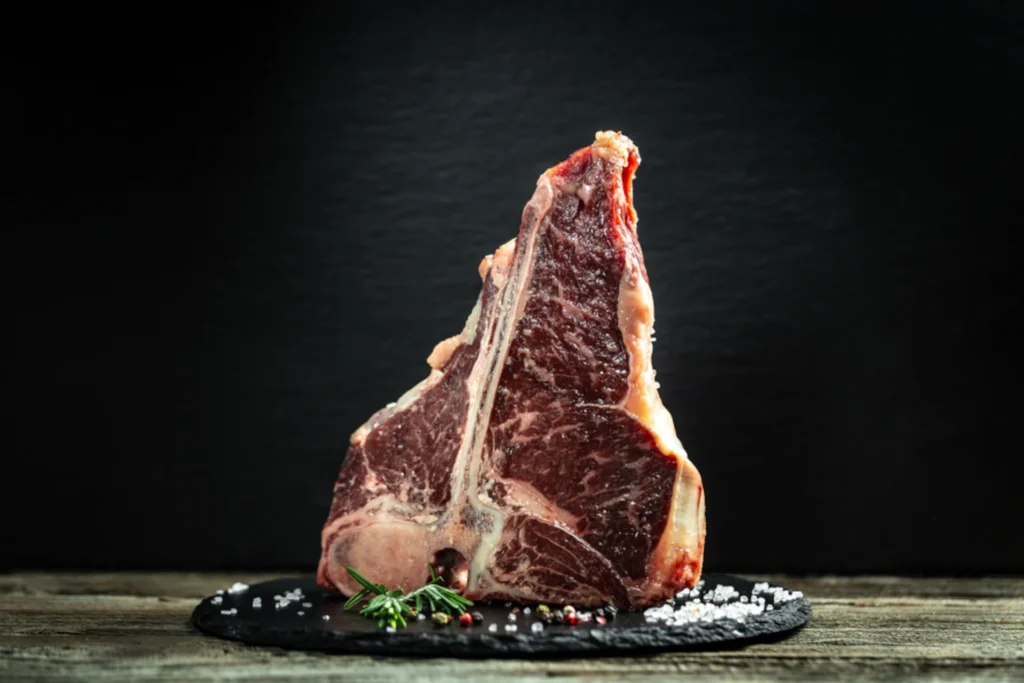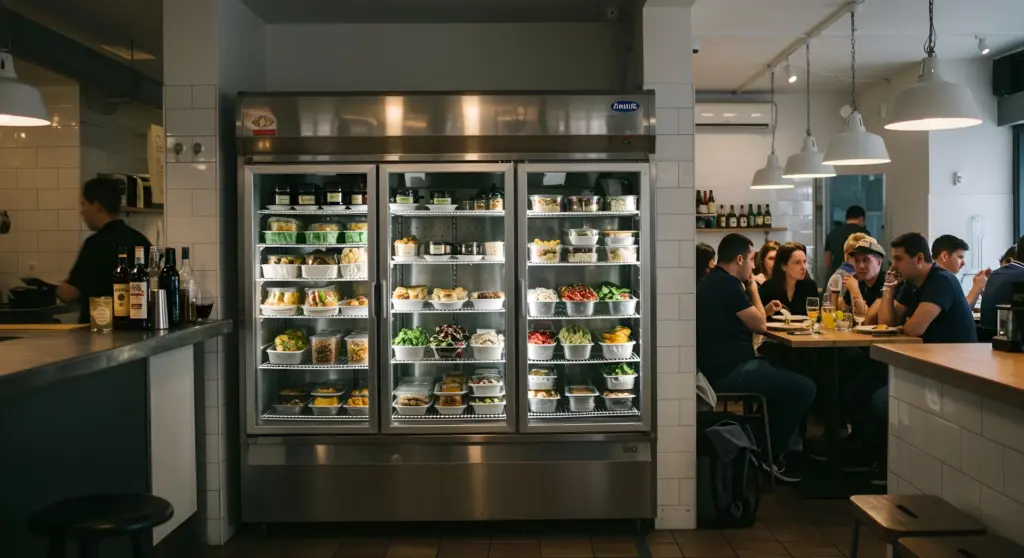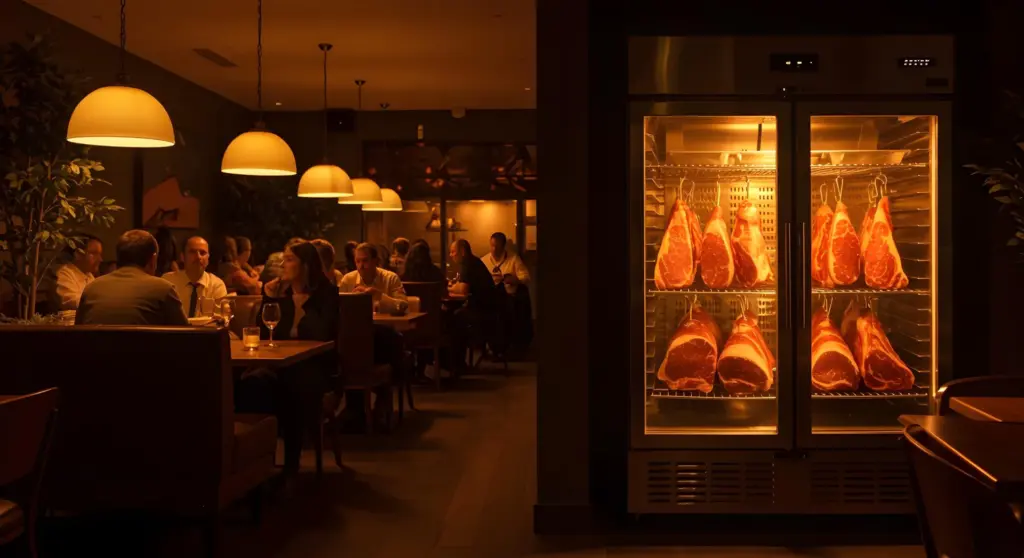The meat maturation is a fundamental technique in haute cuisine and gourmet catering. A well-executed process not only improves the texture and taste of the meatbut also increases its market value and optimises product performance. However, in order to achieve optimal results, it is imperative to apply good maturation practices that guarantee food safety, shrinkage control and final product quality is an essential task for a restaurant.
In this article, we will give some key facts about the best practices in the maturation of meats in restaurants, stressing the importance of having specialised equipment such as the Coreco Gourmet maturation cabinets and the Master Ageing Controllerwhich allows advanced management of the process.
What is meat maturation and why is it essential in gourmet catering?
The meat maturation is a controlled process in which the meat is left to rest under specific conditions of temperature, humidity and airflow. During this time, natural enzymes break down the collagen in the muscle, improving texture and enhancing flavours.
There are two main types of maturation:
✅ Dry Aged:
- It takes place in maturation chambers without vacuum packaging.
- The meat loses moisture, which concentrates the flavour and improves the texture.
- An external crust is formed to protect the inside of the cut.
✅ Wet Aged:
- It is carried out by vacuum-packing the meat.
- It is kept refrigerated to prevent bacterial growth.
- It produces a more tender meat, but without the intensity of flavour of the Dry Ageing.
For any restaurant that specialises in premium cuts, the maturation of meats Dry Ageing is the most valued option and requires best practice, as it offers a deeper flavour and unparalleled texture.
There are studies, such as the one carried out by the Basque Culinary Center in 2023 on Evaluation of prologue dry-aged maturation in real restaurant conditions. With the results of this study, it would be advisable not to exceed 80 days of maturation, stressing that these are indicative results, but not representative, which confirm the need for research in the real context of restaurants to ensure the safety of this type of dry-ripened meat.
Key factors for optimal maturation in restaurants
To obtain a meat well matured and safe for consumptionIn the process, it is essential to control certain parameters. In the following, we present the essential good practices for the maturation of meat in a restaurant:
1. Precise temperature control
Temperature is the most critical factor in the maturation of meat.
- Ideal range: Visit -1°C and 4°C.
- Avoid fluctuations: A few degrees too much can encourage bacterial growth.
- Specialised equipment: Use maturation cabinets with digital control guarantees stability.
🔹 Recommended solution:
The Coreco Gourmet maturation cabinets allow precise and remote temperature adjustment, ensuring safe and secure ripening.
2. Humidity regulation
Inadequate humidity can lead to excessive dehydration or mould growth.
- Ideal range: Between 75% and 85% relative humidity.
- Avoid low humidity: It can cause the meat to lose too much water, reducing the yield.
- Avoid high humidity: Encourages the growth of unwanted fungi.
🔹 Recommended solution:
The Coreco Master Ageing Controller allows fine adjustment of humidity, optimising the retention of juices without the risk of mould.
3. Controlled ventilation and air circulation
The air flow prevents moisture accumulation in certain areas and ensures uniform ripening.
- It must be constant and homogeneous.
- Avoid condensation points or drier areas.
🔹 Recommended solution:
Coreco's maturation cabinets incorporate flow-regulated ventilationThe drying process is carried out in a controlled manner, avoiding uneven drying areas and ensuring uniform maturation.
4. Selection of suitable cuts of meat
Not all pieces of meat are suitable for maturation.
The best options include:
- Tenderloin (chuletón, ribeye).
- Low spine.
- T-bone and Porterhouse.
- Sirloin steak (less common in Dry Aged, but possible).
🔹 Professional advice:
Select meat from cattle with good fat infiltration (marbling)The fat improves texture and flavour during maturation.
5. Optimum duration of maturation
The ripening time directly influences the texture and flavour.
| Maturation time | Effect on meat |
|---|---|
| 15-21 days | More tenderness, but still subtle flavour. |
| 30-45 days | Optimum ripening point: intense flavour and juicy texture. |
| 60-90 days | More concentrated flavour and firmer texture. |
| +120 days | Extreme intensity, only for Dry Aged lovers. |
🔹 Professional advice:
Cuts matured between 30 and 45 days achieve the ideal balance between taste, juiciness and profitability in restaurants.
Common mistakes in the maturation of meats in restaurants
🚨 Failure to control humidity: Excess moisture = mould, lack of moisture = excessive weight loss.
🚨 2. Use low-fat meat: Fat is essential for processing and flavour development.
🚨 3. Do not use specialised equipment: An ordinary refrigerator does not guarantee optimal conditions.
🚨 4. Failure to control airflow: It can lead to uneven dehydration points.
🚨 5. Failure to carry out cleaning and maintenance: A dirty cupboard can develop unwanted micro-organisms.
Benefits of using Coreco Gourmet maturation cabinets
The Coreco Gourmet maturation cabinets are designed to optimise every stage of the process, guaranteeing safety, efficiency and quality of the final product.
| Feature | Benefit |
|---|---|
| Temperature and humidity control | Precise ripening without dangerous variations. |
| Master Ageing Controller | Fine tuning of parameters and shrinkage reduction. |
| Uniform ventilation | It guarantees a homogeneous ripening without dry or wet areas. |
| Remote monitoring | Allows adjustments from anywhere with WiFi or Bluetooth. |
| Energy efficiency | Reduction of electricity consumption and operating costs. |
🔹 IMPORTANT FACT:
The Coreco maturation equipment allow for a controlled reduction of the 10%against the 15-20% of other traditional methodswhich maximises product profitability.
The key to successful maturation in restaurants
Meat maturation is a process technical and delicate which requires precise control of temperature, humidity and ventilation. Apply the good practice described in this article will allow restaurants:
Meat maturation is a technical and delicate process that requires precise control of factors such as temperature, humidity and ventilation. This method, increasingly popular in the gastronomic world, not only transforms the taste and texture of the meat, but can also become a differentiating element for restaurants seeking to offer high quality products.
Internships are everything
Applying good practices in this process ensures the quality and safety of the final product. Maintaining optimal temperature parameters, generally between -1°C and 4°C, as well as controlled humidity between 75% and 85%, is essential to avoid the proliferation of unwanted micro-organisms and to ensure that the meat is safe for consumption. In addition, this care is key to achieving the desired results in terms of flavour and texture.
Maturation significantly improves the organoleptic characteristics of the meat. During this process, natural enzymes break down muscle fibres, resulting in a more tender texture and more intense and complex flavours. Depending on the maturation time, which can vary from a few weeks to several months, different flavour profiles can be obtained that enrich the gastronomic experience.
Meat maturation: A winning strategy for restaurants
On the other hand, implementing this process properly can also be a cost-effective strategy for restaurants. Specialised equipment, such as ripening cabinets, can minimise waste and optimise product yield. Although the initial investment may be significant, the long-term benefits far outweigh this expense.
Finally, offering wet or dry-aged cuts has become a hallmark for many establishments seeking to stand out in the competitive dining market. The ability to offer diners a unique experience with premium meats not only enhances a restaurant's reputation, but also attracts a discerning public willing to pay for exclusive products.
In conclusion, meat maturation is not just a culinary technique; it is an opportunity to raise product quality, increase profitability and position oneself as a benchmark in gourmet meats. With a careful and professional approach, this process can make a big difference in the success of a restaurant.
💡 Do you want to improve the maturation of meats in your restaurant?
Discover the range of Coreco Gourmet maturation equipment and take your professional kitchen to a new milestone. Visit us at Coreco Gourmet. 🚀
Frequently asked questions on the maturation of meat in restaurants
1. How long is it recommended to mature meat for the best flavour and texture?
The ideal maturation time depends on the cut and the desired flavour profile. In restaurants, the most common is:
- 15-21 days: Improved tenderness, but still mild flavour.
- 30-45 days: Optimum point, balance between tenderness and intense flavour.
- 60-90 days: More complex flavour and firmer texture, ideal for gourmet customers.
2. What is the difference between dry maturation (Dry Ageing) and wet (Wet Aged)?
- Dry Aged: It is carried out in a temperature and humidity controlled environment without packaging. It allows the development of intense flavours and a more tender texture.
- Wet Aged: The meat is vacuum-packed, avoiding weight loss. This is quicker and maintains juiciness, but without the complex nuances of the Dry Ageing.
3. Which cuts of meat are the most suitable for maturation?
The best cuts for maturation are those with good fat infiltration (marmoleum) and of sufficient size to withstand moisture loss without affecting quality:
✅ The Tenderloin (T-bone steak, ribeye)
✅ A New York strip (New York strip)
✅ The T-bone and Porterhouse
✅ A Sirloin steak (less common, but possible)
4. What equipment do I need to mature meat safely in my restaurant?
In order to ensure optimal and safe maturation, it is recommended to use specialised maturation cabinetssuch as those of Coreco Gourmetwhich they offer:
🔹 Precise temperature control (-1°C to 4°C).
🔹 Humidity control (75%-85%).
🔹 Uniform airflow to avoid dry spots or mould.
5. Is it safe to mature meat without specialised equipment?
It is not recommended. A conventional refrigerator does not have precise control of temperature, humidity and ventilation. necessary for proper maturation. Using inappropriate equipment can result in bacterial contamination, excessive weight loss and development of unwanted odours.
6. How much shrinkage is generated in meat maturation and how can it be reduced?
As noted above, the meat can lose between 10% and 20% of its weight due to the evaporation of water. However, with advanced technology such as the Coreco Gourmet Master Ageing Controller.it is possible to reduce the decrease to less than 10%maximising profitability.
7. How does maturation affect the final price of meat?
Undoubtedly, matured meat has a higher commercial value due to its improved texture and concentrated flavour. Although weight is lost in the process, the price per kilogramme increases significantlyThis allows you to recoup your investment and generate more profit.
8. How to prevent the growth of mould or bacteria during ripening?
To prevent the growth of mould or harmful bacteria:
✅ Keep humidity between 75% and 85%.
✅ Ensures constant and even air circulation.
✅ Performs regular cleaning of the maturation team.
✅ It is advisable to use cabinets with active carbon filter and regulated ventilation such as those of Coreco Gourmet.
9. How does the breed of the animal influence the maturation of the meat?
Breeds with increased fat infiltration tend to mature better, as the fat helps to retain juiciness and develop a more complex flavour profile. Some of the best breeds for ripening are:
🐂 Angus - High marbling, ideal for Dry Ageing.
🐂 Wagyu - Superior intramuscular fat, exceptional maturation.
🐂 Simmental - Good balance between flavour and texture.
10. How do you know when a matured meat is at its optimum?
It can be determined by looking at these factors:
✅ Colour: A deep, dark red indicates a good process.
✅ Texture: It should feel firm but tender to the touch.
✅ Smell: Aromas of dried fruit, butter or nuts indicate correct maturation. Strong smells of ammonia or decomposition indicate that something has gone wrong in the process.
With these frequently asked questions, your restaurant will be able to implement the safe and cost-effective maturation of meatsoptimising the quality of the final product and offering a premium dining experience to customers. 🚀










